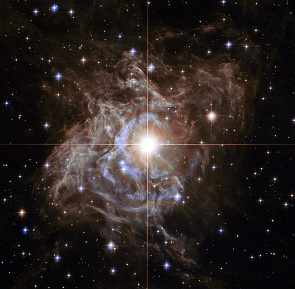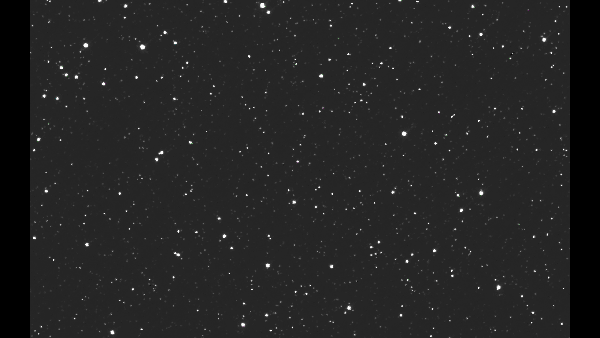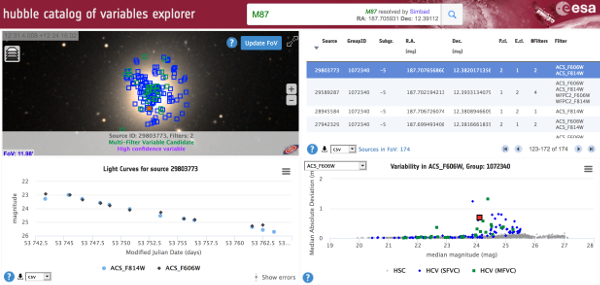Explore the variable sources in Hubble's sky
24 September 2019
The NASA/ESA Hubble Space Telescope has produced a new resource for astronomers: the Hubble Catalog of Variables (HCV), which is the first full, homogeneous catalogue of variable sources based on archival data from the iconic observatory. |
| Hubble image of variable star RS Puppis. Credit: NASA, ESA, and the Hubble Heritage Team (STScI/AURA)-Hubble/Europe Collaboration; Acknowledgment: H. Bond (STScI and Penn State University) |
Even though Hubble is not a survey telescope, it has, over its almost three decade long lifetime, collected a significant amount of repeated observations on a number of patches in the sky. This led the astronomers to search for any variability in the luminosity of sources present in these observations at different epochs in time, performing a comprehensive variability search with the aim to uncover new variables over a range of magnitudes that is difficult to reach with ground-based telescopes.
"The magnitude depth, along with the superb resolution achieved by Hubble and the long time-baseline of its operation, are the features that make such a variable source catalogue unique," says Antonella Nota, ESA Hubble Project Scientist at the Space Telescope Science Institute (STScI) in Baltimore, USA.
The new catalogue was developed by a team of astronomers led by Alceste Bonanos at the National Observatory of Athens, Greece, sponsored by ESA over four years, and in collaboration with STScI.
The HCV is based on the Hubble Source Catalog (HSC), which was created out of publicly available archival Hubble images obtained with the WFPC2, ACS and WFC3 instruments. First released in 2015, the HSC provides photometric measurements of all sources detected from a homogeneous reduction and analysis of Hubble archival images, thereby enabling such a variability search.
Bonanos and her collaborators investigated the potential variability of 3.7 million out of the 108 million sources in the HSC, eventually identifying 84 428 candidate variable sources. After an automated quality control, the team visually inspected a subset of the candidates, suggesting that at least 80% are true variable sources rather than spurious detections that may result from blending, residual cosmic rays or calibration errors.
 |
| Animation of the sky observed by Hubble, including some variable sources (as well as image artifacts). Credit: ESA/Hubble & NASA, B. Merin |
The HCV is the deepest catalogue of variable sources available, reaching down to magnitudes V≤27 mag. It is expected to become a key resource for the astronomical community, providing a more agile dataset for variability studies than the sizeable HSC.
Spanning over several branches of astronomy, the new catalogue comprises variable stars in the Milky Way and nearby galaxies, transient sources like novae and supernovae, and variable active galactic nuclei (AGN). Possible uses include searches for new variable objects of a particular type for population analysis, detection of unique objects worthy of follow-up studies, identification of sources observed at other wavelengths, and photometric characterisation of candidate progenitors of supernovae and other transients in nearby galaxies.
Users are invited to delve into the data employing the HCV Explorer, a new, specially developed online data visualisation tool to access and easily navigate through the catalogue in search of potentially interesting objects and download the corresponding observations for further scrutiny.
 |
| Explore the Hubble Catalog of Variables using the HCV Explorer interface. Credit: ESA/Hubble |
This interactive visualisation tool, developed by the ESAC Science Data Centre at ESA's European Space Astronomy Centre (ESAC) near Madrid, Spain, allows users to search targets by their name or coordinates and locate the variable sources around the desired target in the sky. In addition to that, it provides a series of plots showing the available light curves for each variable source and other relevant parameters, enhancing the discovery potential through visual exploration.
More information
"The Hubble Catalog of Variables (HCV)" by A. Z. Bonanos et al. is published in Astronomy & Astrophysics.
The HCV is accessible via the ESA Hubble Science Archive (eHST) at ESAC, and the Mikulski Archive for Space Telescopes (MAST) at STScI.
For further information, please contact:
Antonella Nota
ESA Hubble Project Scientist, STScI
Baltimore, USA
Email: hubblenewseurope stsci.edu
stsci.edu
Bethany Downer
ESA/Hubble Public Information Officer
Garching, Germany
E-mail: Bethany.Downer partner.eso.org
partner.eso.org
Bruno Merín
Head of the ESAC Science Data Centre
European Space Agency
Madrid, Spain
Email: Bruno.Merin esa.int
esa.int



